|
I head Yara Arts Group, a resident company at La MaMa Experimental Theatre in New York. Yara creates original theatre pieces that are based on masterpieces from the East that are often little-known outside their own culture. Our original pieces begin with extensive research and documentation of traditional songs, epics, and stories gathered in remote areas, that are transformed into theatre productions in collaboration with local folk artists and theatre performers. |
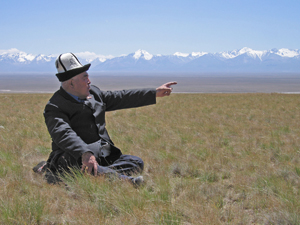
In July of 2006 Yara artists flew to Kyrgyzstan and together with Sakhna actors traveled to Janyl’s homeland in the Celestial Mountains to research the story and meet with people who preserve the story and perpetuate the skills that help anchor this story in the local culture. We met an eagle hunter, and our artists had the incredible opportunity of working with his eagle, learning about this traditional way of hunting which Janyl enjoyed. You can read what a Yara actress wrote about her experience with
The Eagle Hunter
Since our story included scenes of death we wanted to include traditional laments. We were able to meet a number of women who are renowned lamenters and learn about their methods of singing and improvisation. Of course, we also met a number of dastanchi, or epic singers and storytellers, including Kalkan Kerimaly ulu of Kyzyl Tuu, who is a direct descendant of one of the characters in the epic. This elderly man took us into the high valley of Arpa on the Chinese border and made the story of Janyl Myrza come alive for us by pointing out the specific sites where various episodes of the epic took place and clarified many of the questions we had.
Photos by Margaret Morton.

We returned to Bishkek in the beginning of August where I conducted joint workshop rehearsals and developed the outline of the production of Janyl Myrza. We assembled a bilingual text based on our translation with the traditional Kyrgyz folk songs and laments we had recorded and learned on our research trip.
Janyl Myrza is a theatre piece with music, dance, and projections. Janyl Myrza is a great marksman with skill in archery so refined that she never misses. This makes her very powerful, but also provokes neighboring tribesmen to challenge her skill and invade her land. She remains undefeated until she is captured through a trick and forced to take on the traditional role of a wife. Although she retains her respect, the precariousness of her position is revealed in a series of incidences. I directed the piece which grew out of the collaborative efforts of the Yara and Sakhna artists. Music for the production was created by Sakhna’s dastanchi Omurzak Kaypov and musician Asylbek Nasirdinov based on traditional music and songs. The piece was choreographed by Yara artist Shigeko Sara Suga, who incorporated movement from such traditional sources as the way a bow is shot, as well as her personal impressions of horses and eagles filtered through her Japanese-American sensibility. The set included two traditional wooden trunks, as well as large projections by Yara’s photographer Margaret Morton of the areas where the story of Janyl Myrza took place. The presentation featured Yara’s Eunice Wong and Sakhna’s Kenjegul Saltibaldaeva, as two aspects of the heroine, as well as an ensemble of ten who portrayed all the other characters.
The work-in-progress presentation of Janyl Myrza took place in Bishkek August 22 at the City of Artists Exhibition Space. To our great surprise Kalkan Kerimaly ulu came for our presentation in Bishkek from Kyzyl Tuu, a grueling journey from the far south of the country. We held our breath as he got up to speak afterwards. “There were many other shows based on epics,” he said. “But this one was very different. It is unique and creative in the way it portrays the main character. I am very grateful to Kenjegul and Eunice, who portrayed Janyl, as well the other actors. They all performed wonderfully, creating characters of great depth. And thank you to the director.” We were all very moved by his presence and assessment of our work. For pictures and press on the workshop of Janyl Myrza

Work on the production continued in the fall. In February 2007 five actors and two musicians of Sakhna traveled to New York to work with Yara on an American version of the piece. Janyl opened at the world-renown La MaMa Experimental Theatre on March 9 - 25, 2007 to great reception by the audience. This was the first Kyrgyz-American theatre production in New York. The premier was a great success. The audience included both New York theatre-goers and Kyrgyz who live in the US, including Zamira Sydykova, the Ambassador of Kyrgyzstan to America and Canada. The ArtsLink Newsletter named Yara as featured artists of the month, the production was listed as a Voice Choice by Village Voice and a local paper praised the production writing that “the fascinating concept created by the director helps the audience understand the ancient epic today. It becomes a part of contemporary reality.” For pictures and press on the Janyl in New York
Janyl falls in love. Photo by Jonathan Slaff.
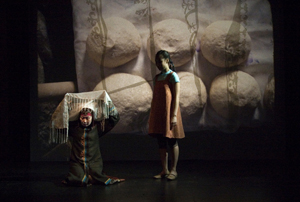
Yara also presented a production by the Sakhna Theatre at La MaMa .Nurlan Asanbekov arrived in New York at the end of March and staged his award-winning production of Testament or Kerez with the Sakhna artists at La MaMa. The Sakhna Theatre founded in 2003 and has created three productions based on Kyrgyz epics: Kerez, based on “Kojojash,” Kurmanbek and Maktyn Dastan. In addition to the performances of the theatre pieces, the Yara and Sakhna artists also performed in series of related cultural events entitled Kyrgyz Spring in New York. These included master classes, concerts and lectures with excerpts from the shows at Columbia University, New York Public Library, the Ukrainian Museum of New York, as well as Skidmore College, Spring Street Gallery and Philadelphia Community College. See Kyrgyz Spring in New York They also presented a cluster of events entitled Kyrgyzstan: Celestial Mountains in Saratoga Springs, upstate New York, which included an exhibit of photographs by Margaret Morton. See Kyrgyzstan: Celestial Mountains in Saratoga Springs, New York
In July 2007 Yara artists traveled to Kyrgyzstan once again, this time to stage the epic for Kyrgyz audiences. I conducted rehearsals at the B’Art Center in Bishkek to create this new version of Janyl Myrza. This time we brought Yara’s award-winning designer Watoku Ueno. who created the set, lights and costumes for the show. Included in the design were slides by photographer Margaret Morton of the areas where the story of Janyl Myrza is set and video collage by Andrea Odezynska. The cast was led this time by American-Korean actress Susan Hyon who with Kyrgyz Kenzhegul Satybaldieva played the two different aspects of the heroine.
Janyl Myrza premiered at the B’Art Center August 9-12, 2007 to enthusiastic responses. The show was presented free of charge, but reservations were required. Originally, we were scheduled to perform four times, but because of the large number of reservations, a fifth show was added. The opening night crowd was addressed by Marie Yovanovitch, the American Ambassador to the Kyrgyz Republic. Akim Tekeshov, the Kyrgyz Deputy Minister of Culture also spoke that night. Present were representative from the Christensen Fund, the Swiss Agency for Development, the Aga Khan Foundation, the University of Central Asia, the EU Commission, as well as representatives from various embassies. We were particularly pleased that the director of the Bishkek Art Museum, Miram Yusupova, and a large number of Kyrgyz artists from various fields enjoyed our productions in Bishkek.
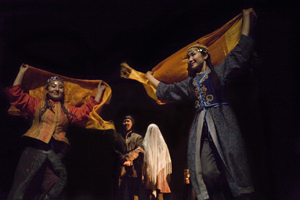 Janyl is captured and married. Photo by Margaret Morton.
Janyl is captured and married. Photo by Margaret Morton.
The Bishkek press highlighted our event and our press release appeared in a number of publications such as the Times of Central Asia, and websites such as Aki Press. It was also mentioned several times on local and national TV. Reviewers such as Yuilia Sushkova, of MSN called it a “very successful experiment,” while Aleksandr Shelepenko of Slovo Kyrgyzstana wrote: “The title role is performed by two women simultaneous – Kenzhegul Satybaldieva and Susan Hyon, one speaks Kyrgyz, the other English. This unusual directorial choice allows very different audience members to understand the ancient epic. It brings together two absolutely different cultures: Kyrgyz and American, the East and the West.”
The Janyl Myrza theatre production was accompanied at the B’Art Center by Janyl Myrza in New York, an exhibit featuring twenty-four large-format color photographs by Margaret Morton from the production at La MaMa last March. A Bishkek reviewer noted: “The artist’s precise work with light, expression, significant detail and the animated faces of the actors allow the spectators to enter into the atmosphere of the epic production. Thus prepared, they will experience the theatre piece with a deeper sense of understanding.”
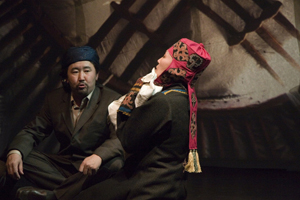
Our production of Janyl Myrza was created for the B’Art Center, a gallery space that we had to convert into a theatre. Watoku Ueno, Yara’s designer adapted the structural elements of the space into a lighting grid. He converted old Soviet theatrical lamps into highly focused lights that could be used with the large number of projections we used in the show. He also built the audience risers that included both chairs and spaces to sit we covered with traditional shyrdaks kuldylyngs and toshoks. Many audience members commented on how we managed to combine the traditional with the experimental even in the space we created for the audience.
After performing five times in Bishkek, the company traveled to Naryn where Janyl Myrza was performed on August 17th and 18th at the Dramatic Theatre. The space and the antiquated lighting equipment of the theatre presented a particular challenge. The theatre had long been stripped of most assets – there were only four light bulbs. We had to buy theatrical light bulbs from the Symphony in Bishkek to use in Naryn. Although the artistic staff of the theatre was very forthcoming, the managing director scheduled a concert for a pop star (without informing anyone) during the exact time that we had been scheduled for technical work. It was particularly sad and annoying since only twenty people showed up for the concert. We lost valuable time and also became seriously concerned about filling the 500 seat house. The artists of the theatre rallied to help us. They had already distributed our posters and press releases which appeared in the local Kyrgyz papers, including Tenir-too, the Naryn oblast paper. They put us in touch with a popular FM station that constantly announced our show. Damira Baratbaeva, the lead actress of the theatre, helped us distribute our special invitations to the appropriate oblast and city government officials, as well as other dignitaries.
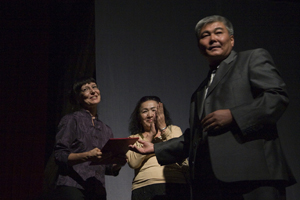
On opening night Ajybek Kasymaliev, the governor of Naryn, presented us with an official letter of thanks in which he wrote: “We must consider this a fundamental work of art not simply in terms of Kyrgyzstan, but for all of Central Asia. Here the past and the present are brought together, as well as two nations.” Many Naryn officials attended our opening night and toasted us at the reception afterwards. We were very moved by Bermet Omurova’s assessment of our work. A leading actress of the Naryn Theatre, she is also a renowned lamenter or koshokchi. The previous summer we had recorded her during our research trip and included our version of her lament in our show. She said she was very proud that her lament was one of the highlights of this production of Janyl Myrza. It was a pleasure, she said, to see one’s work interpreted by the next generation.
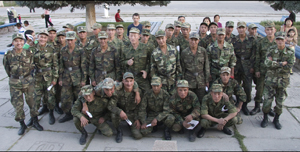
The second performance in Naryn was truly our trial by fire. The soldiers of the Naryn battalion, attended en masse. Soldiers we were told are a notoriously unruly audience. We did not know how they would respond to a show about a woman warrior. We decided that we needed to address them directly before the theatre piece. Director Virlana Tkacz spoke about how Janyl Myrza was a warrior from Naryn, just like they were, and explained the idea behind the stylized portrayals of war in the show. To our great relief, the soldiers proved a great audience and loved the show, taking many pictures with us afterwards.
In addition to the theatre production, the Naryn Art Gallery presented Margaret Morton’s photography exhibit, Janyl Myrza in New York, which opened on August 16. It was introduced by a lecture by director Virlana Tkacz entitled, The Making of Janyl Myrza with slides for our research trips and various stages of production, music and excerpts from the performance. The lecture sponsored by the University of Central Asia.
Although the sophisticated audiences of Bishkek and even the soldiers of Naryn loved our show, we were very nervous about how the villagers in Janyl’s homeland would react to our interpretation of this epic considered almost sacred by the locals. The memory of these events which took place over three centuries ago is still very much alive in the area. For instance, our audience members included a teenager actually named Janyl Myrza and Kalkhan Kerimalu, a local story teller, who claims he is a direct descendant of one of the characters in the story.
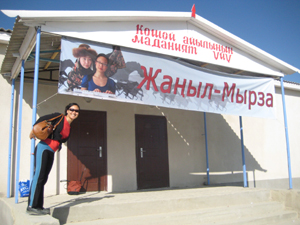
The Culture Club of Kara Suu was relatively new, but it was not designed with theatre in mind. There was no grid, the walls and floors were made of cement and tile. The organizers of the Koshoi Korgon Festival arranged for a wooden floor to be installed in the performance area, but the promised grid never materialized. Once again our designer created a miracle, and managed to hang our lights from the ceiling supports. Then the village electrician hooked us up directly to the local power source, which immediately blew all our bulbs. We called all the electricians we knew in Bishkek for advice. Finally, we appealed to Konogaly Matkabylov, the Akim of At-Bashy, to send us a consultant from the power station. The head electrician for the AES arrived and after checking the village discovered the improper hook-up, saving our show.
We were originally scheduled to perform at 7PM, but the villagers asked us to postpone the show to 9PM on opening night, so that the young people of the village who had a rehearsal for the upcoming festival could attend. We, of course, agreed. The two hundred seats were packed with twice as many spectators. The audience members filled the lobby which showcased the photography exhibit. As photographer Margaret Morton recalls: “The village residents surged into the theatre opening night, pulsating with energy and anticipation. A group of young children clustered around an actor as he guided them through the photo exhibition, spellbound as he pantomimed every scene. Throughout the performance, the audience excitedly pointed and exclaimed when projections of my photographs from our 2006 research trip appeared in the set design; every mountain pass, valley, and river is integral to their daily life. Their personal involvement and participation filled the theatre with an emotional intensity that layered the images with new meanings and underscored the relevance and timelessness of the epic Janyl Myrza.” At the end the audience of grandmothers, villagers and children stood up to enthusiastically applauded our experimental theatre piece and we were very moved.
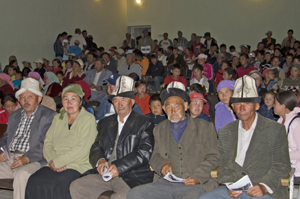
The second performance in Kara Suu was even more packed, and included an opening speech by Konogaly Matkabylov, the Akim of the At-Bashy region, as well as the deputy director Guldysun Bushekieva. The mother of Ascar Salymbekov, a much respected local elder, rose to speak after the show, stressing the importance of our production for the village and thanking the artists.
In Kara Suu we were overwhelmed by the hospitality of the village on all levels. We were met with such a generous spirit by our host families, as well as the village head, Jashibek Nurkasymov. Kalkhan Kerimalu, a local story teller who the previous year had taken the members of the cast to the valley of Arpa where a part of the Janyl Myrza story took place, presented the cast members with copies of his book on the epic. We were particularly moved that Janyl Alibekova, Kyrgyzstan’s greatest felt artist who lives in a neighboring village, but whose work graces the collection of the British Museum, came to see our show. She spoke very enthusiastically about how she admired the fact that we managed to create a contemporary art work so deeply saturated in the past. She also presented us with a gorgeous matching set of shyrdaks.
In addition to our performances, our American-Kyrgyz company was able to travel to the traditional areas on the southern rim of Issyk-Kul to meet with eagle hunters and bow makers. We also rehearsed our show (which starts and ends with everyone in the cast portraying a horse) on the beach for an audience of wild horses. While we were in the At-Bashy region we traveled to Tash Rabat to see the ancient caravansary and to spend time with people who (to quote our epic) raise “horses like the wind.”
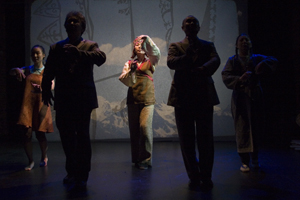 Janyl returns to her homeland. Photo by Margaret Morton.
Janyl returns to her homeland. Photo by Margaret Morton.
We believe that our performances helped introduce our Kyrgyz audiences to their own epic past buttressing a sense of local pride in their heritage and helping envision its future. Both Yara and Sakhna are small theatre companies interested in creating contemporary work grounded in traditional material. We believe we build understanding by introducing audiences in Bishkek and New York, Naryn and Kara Suu to the wealth and diversity of Kyrgyz culture as it is interpreted by contemporary Kyrgyz and American artists working hand-in-hand. Janyl Myrza is truly an American-Kyrgyz collaboration and draws as much on the talents of the American artists as on the knowledge of our Kyrgyz colleagues. Everyone was constantly amazed to discover that Susan Hyon was born in New York and spoke no Kyrgyz because her every gesture and glance conveyed such a deep understanding of her Kyrgyz colleagues. Our “authentic” traditional costumes were actually designed by a Japanese-American artist. The depth of our understanding of this ancient story and its nuances constantly amazed the local population and to them were proof of the real sensitivity Yara’s very diverse company of artists has towards other cultures. Our theatre piece delighted our audiences and let them discover that the “familiar can still amaze” if presented in an interesting way. We hope that our show can continue to live and will find new adherents when shown to audiences both in the other regions of Kyrgyzstan and at international festivals. Recently, we were delighted to hear that our production will be the topic of one of the papers presented at a UNESCO Conference on preserving the epic tradition.
BRAMA, Inc.
Copyright (c)1995-2007 Yara Arts Group; all rights reserved. Photographs by Margaret Morton, Jonathan Slaff and Susan Hyon
|
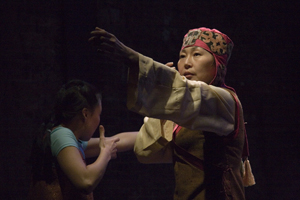 JANYL MYRZA RETURNS TO HER HOMELAND
JANYL MYRZA RETURNS TO HER HOMELAND